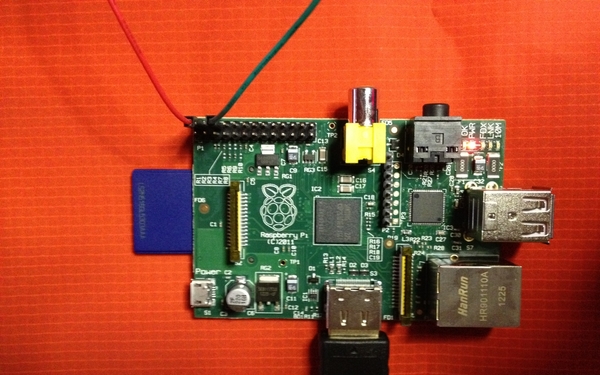Raspberry Pi - Power Up using the 5V Header Pin

Just a quick experiment powering the Raspberry Pi using the 5VDC and GND pins via the 26P GPIO header. The Pi powered up with no problems including providing sufficient power for my direct attached Edimax EW-7811Un 150 Mbps Wireless 11b|g|n Nano Sized USB Adapter. I was able to remotely connect to the Pi using the WiFi connection and control the GPIO pins.
Important Note!
Please be aware that if you attempt this, you should use a regulated power supply. Don't connect a battery pack or unregulated power supply unless you are using a voltage regulation circuit. Un-filtered/unregulated power may cause damage to you Pi.

You can see the specific header pins used in the photo below:
- PIN 2 = +5VDC (VCC) (Red wire in photo)
- PIN 6 = GROUND (Green wire in photo)
* Raspberry Pi is a trademark of the Raspberry Pi foundation.












 Wednesday, September 12, 2012 at 1:45AM
Wednesday, September 12, 2012 at 1:45AM

Reader Comments (8)
I have a type B version 2 RPi and according to the schematics, the only thing between the supported +5V power port and pin 2 on the header is "miniSMD F3 1A1 6V" which seems to be a 1Amp fuse. There is also a 5V zener diode (?) between +5 and ground. Your comments above about use of a regulated power supply are somewhat valid but IMHO are no dicier than use of a standard USB power cable.
According to the schematics, both version 1 and 2 of the "B" have +5V power tied together on header pins 2 and 4, as well as test point TP1.
On type B version 1, there are 2 "miniSMDC" fuses (F1 and F2; one for each USB port) between the USB connector (pin 1) and the +5V buss (plus some capacitors to ground). On type B version 2, the fuses and capacitors are not there and each USB port (pin 1) connects directly to the +5V buss.
In my analysis, version 2 boards can be powered by +5V coming back from a USB hub or powered device (is this valid according to USB rules?).
It is not clear to me if version 1 boards can be powered by +5V going through the fuses. They seem to be 140mA. I don't think that this would work if either or both of the HDMI or ethernet ports were active.
From the +5V buss, there is a diode and capacitor going to the HDMI +5V line (pin 18) (so the RPi can not be powered from HDMI).
tl;dr: The RPi version 1 could be powered with +5V via the microUSB power port or pins 2 or 4 on the P1 header. Version 2 can be powered the same way as well as through the USB device port. [I don't know about the type "A" board.]
@Harvey,
Thank you for the detailed info. I included the "regulated" power supply comment to avoid people from complaining that they burned up their Raspberry Pi based on my article. I think most modern 5VDC power supplies used for cell phones and tablets provide sufficiently clean power, but some older power supplies my be "dirtier" power with fluxuating voltage.
I have read some blog posts where users are using a powered USB hub to power their Raspberry Pi. Also some users have bypassed the polyfuses between the 5V rail and USB ports. The trick is that the USB hub needs to provide sufficient amperage of 700 mA which is above the required amperage of the USB spec for a single port. Some powered USB hubs can deliver this amount of power while others cannot. YMMV
Thanks, Robert
kirdayg e3d3fd1842 https://gardenlocked.com/symkadito
barbecla d4f391380b https://cdn.thingiverse.com/assets/af/34/2a/96/fe/SsangYong_EPC_022013rar.html
barbecla d4f391380b https://cdn.thingiverse.com/assets/af/34/2a/96/fe/SsangYong_EPC_022013rar.html
barbecla d4f391380b https://cdn.thingiverse.com/assets/af/34/2a/96/fe/SsangYong_EPC_022013rar.html
barbecla d4f391380b https://cdn.thingiverse.com/assets/af/34/2a/96/fe/SsangYong_EPC_022013rar.html
barbecla d4f391380b https://cdn.thingiverse.com/assets/af/34/2a/96/fe/SsangYong_EPC_022013rar.html